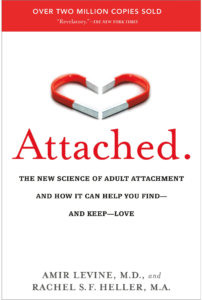by Melinda Coles
What is my attachment style?
Are you Anxious, Avoidant or Secure? This is the question Dr Amir Levine and Rachel S.F Heller ask in their book “Attached” and can lead to a greater understanding of the dynamics of our close relationships.
As adults, we inter-relate with each other based on one of the three most common attachment styles, and the attachment style we each develop stems from childhood and our specific relationship with our primary caregiver.
Secure Attachment Style
If our parents or primary caregiver were sensitive, available and responsive to our needs, we are likely to develop a secure attachment with them and this will flow into healthy, mutually respectful, loving relationships in adulthood. About 50% of people fall into the securely attached category. It is also most likely that these parents also grew up with securely attached parents.
Avoidant and Anxious Attachment Styles
If, however, our parents were unavailable, distant, rigid, or less responsive to our needs, we are likely to be within the 25% group of people who develop an avoidant attachment style, and if our parents were inconsistently responsive to our needs, we are likely to develop an anxious attachment style, along with 20% of the population. These parents may be living with mental illness, addiction, domestic violence, social isolation or grew up with a parent/s that were experiencing life challenges or/and in recovery from their own childhood traumas.
Some people can also develop a combined avoidant-anxious attachment, whereby they can alternate between the two depending on the situation they are facing or the relationship they are in. These rare people comprise about 5% of the population.
 How do attachment styles impact relationships?
How do attachment styles impact relationships?
Securely attached people are essentially programmed to expect their partner to be loving and responsive and they don’t think about losing their partners love. They are comfortable with intimacy and closeness and have an ability to communicate their needs effectively as well as respond to their partner’s needs. This security is generated by loving, responsive primary carers who were available to provide for their child’s needs in healthy ways.
Conversely, avoidant attachers tend to keep people at a distance and repress rather than express their emotions. They can feel challenged and overwhelmed when people get too close to them and can instigate feelings of abandonment in the other when in relationships. This attachment style is a fierce defence to protect their basic underlying need for intimacy and connection which they are often ashamed about and react to this shame by pushing the other person away. The shame stems from this primal need not being met by their primary carer and thus the need moves into shadow and becomes a part of themselves which they wish to disown.
Anxious attachers on the other hand, are highly sensitive and hyper-vigilant to threats to the relationship. This means if they detect even a slight hint that something may be wrong in the relationship, their attachment system will be activated and the only way their anxiety can be calmed is by getting a clear indication from their partner that he/she is truly there for them and that the relationship is safe. This attachment style stems from their experience of being inconsistently seen, heard and validated by their primary carer in childhood, and thus they develop a fear of being abandoned and a need for validation and assurance that they are safe and secure.
How can we become more secure?
We all have the basic human need to be seen, acknowledged and loved for who we are and if these needs are not met in our relationships, and we have an insecure attachment, we can move into activated anxiety or avoiding intimacy behaviour.
The way through this maze is for
- Anxious attachers learn to honour their deep need for safety and security in relationships, and to express that need to their partner, and
- Avoidant attachers learn to open up to their need for intimacy and closeness in their relationships and to trust that another person may be able to meet that need.
Once we have identified our primary needs, the next step is to communicate those needs in our relationships. This can be very challenging if you are not used to it, and may take a lot of courage and practice.
Five principles to follow for healthy and effective communication:
- Be genuine and completely honest about your feelings
- Focus on your needs using language such as “I need”, “I feel” and “I want”
- Be clear and specific in your communication, and state exactly what it is that is bothering you to your partner.
- Don’t blame – communication does not work if you blame the other person. Communication is about you expressing your needs in the relationship and working out how those needs can be met. Avoid “You” statements where fingers are pointed (metaphorically)
- Be assertive and non-apologetic .Your relationship needs are valid, as are your partners. By asserting your needs, you open the door to a more fulfilling, intimate connection.
 Written by Melinda Coles
Written by Melinda Coles
Melinda offers a person-centred approach in a safe, confidential setting so you can be at ease and truly go into a space to explore your emotions and what underlies them. She has specific experience with co-dependent–narcissistic relationship dynamics.
Click here to learn more about Melinda.



